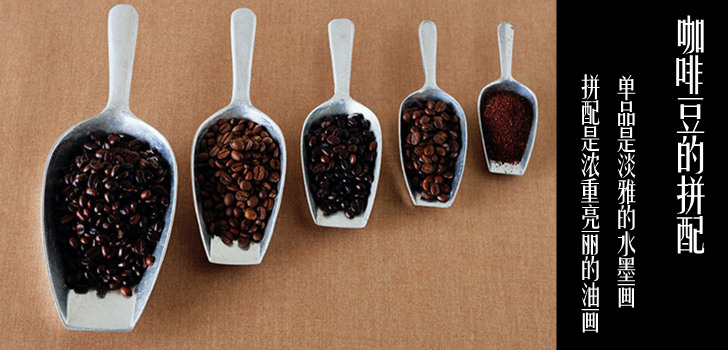Coffee Blending

Excluding commercial purposes such as cost reduction, individual coffee itself can show natural fragrance, softness and sweetness. But most of the coffee is not enough in other aspects because it has its own special flavor. Such as lack of special flavor, lack of depth, lack of strength, or a certain flavor is too strong. In order to make up for these deficiencies, several kinds of coffee beans with different characteristics can be combined to create a more ideal taste and more beautiful flavor.
Coffee blending is like a painter adjusting and creating charming colors in a color palette, and the blender can also mix coffee beans to produce an attractive flavor. Therefore, it is not too much to say that matching is an art. As an artist, the assembler needs not only a wealth of experience and inspiration, but also through fine scientific calculation.
For a good coffee mixer, coffee beans are like a kaleidoscope in the hand, changing into a variety of coffee, which is a very vivid and wonderful feeling for both the creator and the user. This is the charm of matching art. The single item is a light and elegant ink painting, and the combination is a thick and bright oil painting. For a creator, the loveliness of matching is that the brush in hand can play more autonomy. The following points should be made clear before matching:
1. The theme of matching
Determine the goal of the match and what kind of flavor you want to match.
two。 Understand the characteristics of each coffee bean
In order to mix coffee, you must first be familiar with the characteristics of each individual coffee and understand the subtle relationship between roasting degree and coffee flavor.
3. Determine the task of participating in the blending of coffee beans
Since a variety of coffee beans are used together, it is necessary to know whether the task of each kind of coffee bean is to make it show soft bitterness, bright sour taste or heavy mellow taste, which need to be well distributed. Generally speaking, the following principles should be followed when matching:
one。 Blending of raw beans requires the use of coffee beans with their own characteristics, and avoid using coffee beans with similar flavor. The choice of raw beans can be considered from three aspects:
1. Raw bean treatment method: that is, whether raw beans are treated by washing method or drying method, which has a lot to do with the flavor of coffee beans.
two。 Producing areas of raw beans: coffee producing areas are generally divided into three major regions, including about 20 countries in Central and South America, namely, Brazil, Colombia, Guatemala, Mexico, Delaware, Jamaica and Peru, and about 10 countries in Southeast Asia, namely, India, Indonesia (including Java and Sumatra) and Papua New Guinea. There are about 25 countries in the Arab and African regions, namely, Ethiopia, Kenya, Tanzania, Arabia, Uganda and so on.
3. Coffee bean flavor: refers to the coffee bean flavor of sour, bitter, sweet, alcohol in which blindly prominent, or all aspects of more balanced neutral beans. Now the most commonly used raw beans are Brazil, Colombia and Mocha. two。 The number and proportion of coffee beans involved in blending
Since it is a blending, it naturally refers to the blending of more than two kinds of raw beans, but a special example is that the same kind of coffee beans with different roasting degrees can be matched together, or even the new crop and aged coffee or old crop of the same kind of coffee beans can be matched together, so the type referred to in the blending is not only the coffee variety, but also extends to the flavor of the coffee. Generally use 2 to 6 kinds of coffee beans when blending, too many kinds will not be able to show the unique flavor of coffee. Blended coffee usually does not take the 1:1 blending ratio, because this may suppress each other's unique flavor, so the blending must be primary and secondary in order to produce a better taste than a single coffee.
The most important thing to mix coffee is to keep trying, so you should use a mathematical combination to draw up a blending schedule before blending, and then determine the best plan through the process of blending cups. Don't think that this is a negative and stupid approach. In fact, a good cup of coffee can only be made by the experience, inspiration and tireless attempt of the blender.
Important Notice :
前街咖啡 FrontStreet Coffee has moved to new addredd:
FrontStreet Coffee Address: 315,Donghua East Road,GuangZhou
Tel:020 38364473
- Prev

How to grind a good cup of coffee
A good cup of coffee requires not only the careful preparation of baristas, but also the careful grinding of coffee beans. Baristas' every move determines the color, taste and flavor of a cup of coffee. Baristas are the most important decision makers of coffee, and how to grind coffee beans has become the basic technology that every barista should have. (1) generally speaking, the principle of grinding is good.
- Next

Take stock of coffee pedigree culture of countries all over the world
Not only human beings have pedigree theory, red wine has pedigree theory, in fact, even coffee has pedigree theory. Like red wine, the quality of coffee beans has a lot to do with the origin. Brazil Santos Coffee is the world's largest coffee producer. One of the most famous is Sandos Coffee, which tastes mellow and neutral and can be boiled directly or mixed with other kinds of coffee beans into comprehensive coffee. Other
Related
- Why are the coffee in some coffee shops not enough after being frozen? What should I make up for my American latte cappuccino coffee after being frozen?
- How much water does it take to steam coffee by hand? Why is the coffee brewing and steaming time 30 seconds? What is the purpose of steaming coffee?
- The suspected drink contains too much caffeine! Overlord Tea Lady responds urgently!
- Starbucks rejects antique paper coupons?! Netizen: Missed marketing opportunities!
- What ratio of water temperature and ground does the smart cup method use to press coffee? The difference between brewed coffee and filtered coffee?
- What is the standard process for the purpose of coffee cup testing? What is the difference between hand-brewed coffee and cup testing?
- How to use hand-brewed coffee paragon small golden balls? How does cold coffee lock in the aroma of coffee?
- Is American coffee black? What is the difference between American coffee and drip coffee?
- Unexpected! Well-known tea beverage brand Lele Tea will withdraw from the Zhengzhou market!
- Starbucks enters the fashion and beauty industry?! Netizen: Give me an ice American eye cream

